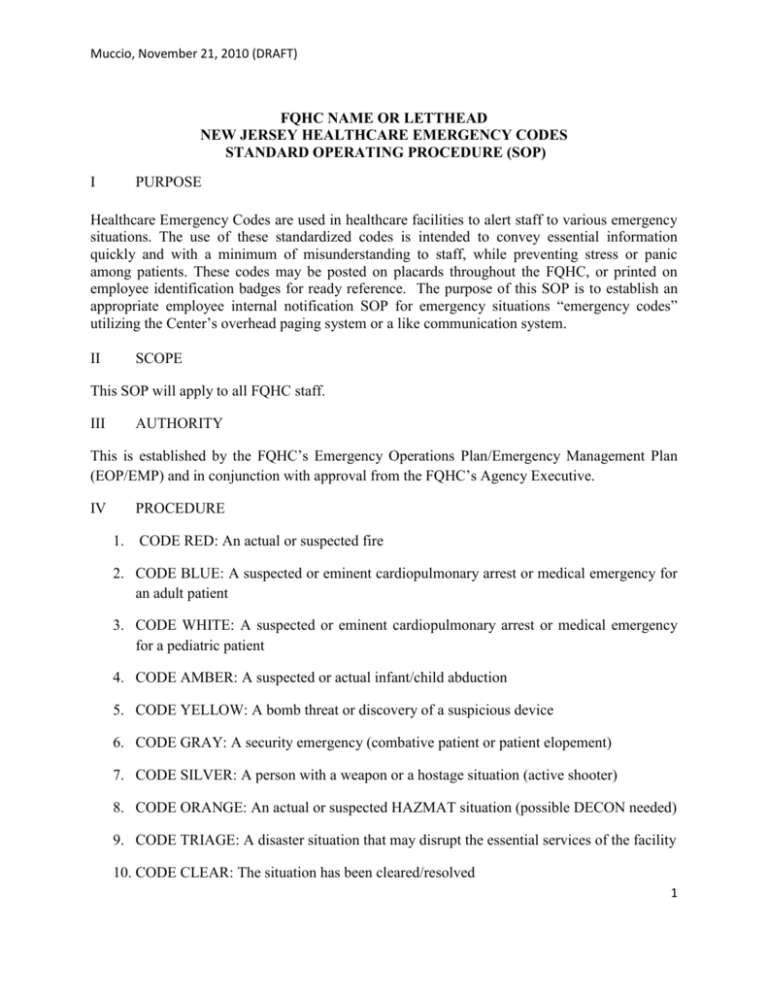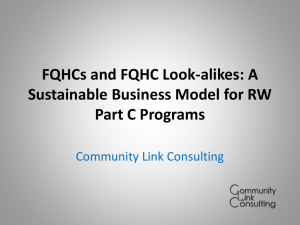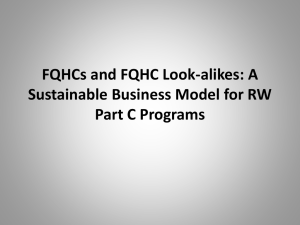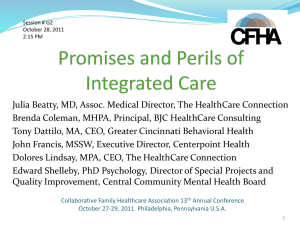Healthcare Emergency Codes SOP | FQHC Procedures
advertisement

Muccio, November 21, 2010 (DRAFT) FQHC NAME OR LETTHEAD NEW JERSEY HEALTHCARE EMERGENCY CODES STANDARD OPERATING PROCEDURE (SOP) I PURPOSE Healthcare Emergency Codes are used in healthcare facilities to alert staff to various emergency situations. The use of these standardized codes is intended to convey essential information quickly and with a minimum of misunderstanding to staff, while preventing stress or panic among patients. These codes may be posted on placards throughout the FQHC, or printed on employee identification badges for ready reference. The purpose of this SOP is to establish an appropriate employee internal notification SOP for emergency situations “emergency codes” utilizing the Center’s overhead paging system or a like communication system. II SCOPE This SOP will apply to all FQHC staff. III AUTHORITY This is established by the FQHC’s Emergency Operations Plan/Emergency Management Plan (EOP/EMP) and in conjunction with approval from the FQHC’s Agency Executive. IV PROCEDURE 1. CODE RED: An actual or suspected fire 2. CODE BLUE: A suspected or eminent cardiopulmonary arrest or medical emergency for an adult patient 3. CODE WHITE: A suspected or eminent cardiopulmonary arrest or medical emergency for a pediatric patient 4. CODE AMBER: A suspected or actual infant/child abduction 5. CODE YELLOW: A bomb threat or discovery of a suspicious device 6. CODE GRAY: A security emergency (combative patient or patient elopement) 7. CODE SILVER: A person with a weapon or a hostage situation (active shooter) 8. CODE ORANGE: An actual or suspected HAZMAT situation (possible DECON needed) 9. CODE TRIAGE: A disaster situation that may disrupt the essential services of the facility 10. CODE CLEAR: The situation has been cleared/resolved 1 Muccio, November 21, 2010 (DRAFT) I. Initiating an Emergency Code When an emergency situation occurs in the facility, the employee should contact the facilities designee for overhead paging or a predetermined suitable contact (if no overhead paging system is available) to provide an initial briefing of the emergency including the location of the emergency and nature of the incident. The emergency page system operator or predetermined suitable contact will immediately notify the appropriate management authority and response personnel in accordance with the FQHC’s EOP/EMP or code-specific SOP. If an overhead page is required, the emergency page system operator will use the appropriate emergency code (see above) and repeat it three times via the overhead paging system. If the facility does not have an overhead paging system than another form of suitable interoperable communication equipment should be utilized (walkie-talkies, Nextel Direct, etc) following the same procedure as above (repeat code three times). II. When the incident response is complete or the emergency has been resolved, the appropriate authority (Incident Commander, Center Administrator, etc) will call the emergency page system operator and request that they announce “Code Clear” three times. If an overhead paging system is not available this should be communicated using the same communication system used to initiate the code and announced three times. III. Terminating an Emergency Code Education & Training All employees must be familiar with the standardized healthcare emergency codes and: o Code Color/Names o Code Definitions o Appropriate number/person to contact (Emergency Page System Operator or suitable emergency contact) to notify of in case of an emergency. o Their specific responsibilities and procedures during an emergency code incident. o Emergency codes will be reviewed in each new hire orientation and refreshed annually at staff meetings. 2




